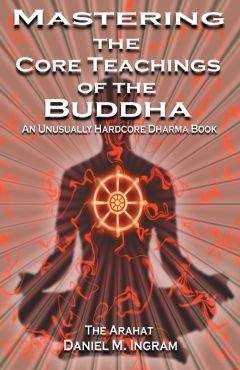Daniel Ingram - Mastering the Core Teachings of Buddha - An Unusually Hardcore Dharma Book
На сайте mybooks.club вы можете бесплатно читать книги онлайн без регистрации, включая Daniel Ingram - Mastering the Core Teachings of Buddha - An Unusually Hardcore Dharma Book. Жанр: Прочее издательство -,. Доступна полная версия книги с кратким содержанием для предварительного ознакомления, аннотацией (предисловием), рецензиями от других читателей и их экспертным мнением.
Кроме того, на сайте mybooks.club вы найдете множество новинок, которые стоит прочитать.

Daniel Ingram - Mastering the Core Teachings of Buddha - An Unusually Hardcore Dharma Book краткое содержание
Mastering the Core Teachings of Buddha - An Unusually Hardcore Dharma Book читать онлайн бесплатно
don’t let my descriptions of what can sometimes happen script you into imagining that the Dark Night has to be a gigantic problem. It absolutely doesn’t. These descriptions of what can sometimes happen are merely there to help those who do encounter these sorts of problems to realize that these things can happen and so be more able to deal with them skillfully. There is no medal awarded for having a tough time in the Dark Night or for staying in it for longer than necessary, much to my dismay.
One of the more bizarre potholes we can fall into in the Dark Night is to become identified and fascinated with the role of The Great Spiritual Basket Case. “I am so spiritual that my life is a non-stop catastrophe of uncontrollable insights, disabling and freakish raptures, and constant emotional crises of the most profound nature. My spiritual abilities are proven and verified by what a mess I am making of my life.
How brave I am to screw up my life in this way! Oh, what a glorious and holy wreck I am.” Both my sympathy and intolerance for those caught in this trap is directly related to the amount of time I have spent in that trap being just like them. Whereas we should not try to pretend that the Dark Night hasn’t made us a basket case if it has done so, we should neither revel in being a basket case nor use the Dark Night as an excuse for not being as kind and functional as we can possibly be.
One way or the other, when we finally give up and rest in things as they are without trying to change them or be them, i.e. are very accepting of our actual humanity as well as clear about the Three Characteristics of mental and physical phenomena, there arises...
11. EQUANIMITY
Finally, we really begin to understand and surrender to the truth of things. We accept the truth of our actual human lives as they are at a deep level. All of the “stuff” that the Dark Night may have brought up may still be going on, but somehow it has lost its ability to cause real trouble. Equanimity is much more about something in the relationship to phenomena than anything specific about the phenomena themselves.
Equanimity can have sort of a rough start, strangely enough, as well as some mildly painful and irritating sensations, but the meditator feels that some barrier has finally broken, a weight has lifted and practice can continue.
203
The Progress of Insight
However, this stage can be such a relief after Re-observation that it is very tempting to solidify it into the fourth samatha jhana either because doing so is so nice or because of fear of falling back to Re-observation, which can easily occur. However, as I continue to mention, not investigating the qualities of this stage, such as peace, ease, and a panoramic perspective, causes failure to progress and makes falling back to Re-observation more likely.
The first vipassana jhana is about building up the basic skills of what is a physical sensations, what is a mental sensation, how they relate, and what the Three Characteristics feel like in practice. The Arising and Passing away is about seeing this very clearly and profoundly for the object of meditation. The Dark Night is about these insights then coming around to the background and seeing more complex emotional and psychological constructs of mental and physical sensations as they are. The fourth vipassana jhana, meaning this stage, is about seeing the true nature of even more complex, inclusive, subtle and fundamental things, like space, awareness, investigation, wonder, expectation, anticipation, peace, ease, questioning, and those sorts of things in ways that cut through the center and include the whole background and foreground as well.
This early stage can feel very familiar and “normal,” like we have remembered something simple and good from our childhood. If we felt weary of the world in the Dark Night, we may suddenly find that the world is just fine and may even be more engaged with it and excited about it than before. Again, these potentially radical mood swings can be very disorienting to those with whom we have close relationships. Try to be sensitive to this and their feelings. Confidence returns, but whereas there may have been a Rambo-like quality to it during stage 4. The Arising and Passing Away, now there is more of the cool, charming confidence of James Bond (sorry about the purely masculine images here).
Somewhere in here there can arise a tendency to see the world and those in it in very strange and unusual ways. I will give one example from my own experience, but realize that tremendous variation is possible here, so don’t take this too seriously. It is meant to try to convey a very general concept. I remember looking around me at all the 204
The Progress of Insight
people on retreat and even all the chickens, birds and puppies in the monastery, and seeing them all simultaneously as “little mush demons”
(little squat greenish creatures with big, sad mouths and eyes) and fully enlightened buddhas at the same time. They were both. In fact, we were both.
We were deluded and small, yet transcendent and luminous. I
could see in some very strange way exactly how each of them, including me, was caught in the world of form and confusion, trying to find happiness and yet doing so from such a small and frightened place, and yet all of this was vast buddha nature, all of this was the natural, luminous and compassionate dance of God. Such strange perspectives that try to resolve paradoxical insights do not always occur, but this is included here in case they do and perhaps to provoke knowing laughter from those with their own unique stories from this part of the path.
More sexual and stylized versions of these experiences can also explain where some of the more exotic tantric teachings come from.
Sometimes the early part of stage 11 can produce a real sense of freedom in the conventional sense, freedom from cares, worries, and even responsibilities and social conventions. One may sometimes feel that one is simply beyond everything, and it must be admitted that this is a wonderful feeling. It tends to fade quickly enough on its own, but it might be possible to get caught by it if one stopped practicing entirely.
Those who became spiritual fanatics or freaks after the A&P and during the Dark Night may now begin to act much more like their old selves, with their spiritual path being much less of a Big Holy Deal. About damn time…
Visions of bright lights may arise once more, but they are really more associated with stage 4, The Arising and Passing Away. Again, as with that earlier stage, the meditator is able to sit for longer and longer periods of time and begins to clearly perceive the Three Characteristics with spaciousness and breadth. The big difference is that the A&P is more about the object of meditation and Equanimity is much more about the whole sensate universe. There is less rapture and more equanimity than in the stage of the Arising and Passing Away. There are rarely if ever the spontaneous physical motions and odd breathing patterns that come with that earlier stage. Unfortunately, just to make 205
The Progress of Insight
things confusing, there is often a single double-dip unknowing event, with one being halfway down the breath and the other at the end of that breath, very soon after the shift from Re-observation to Equanimity.
In the early part of this stage, reality may appear a bit “chunky” for a while, and practice may seem quite possible but may seem to require steady but sustainable work. If one is tired, one may begin having dropouts that are similar to what occurred in Dissolution but more extreme. It may be hard to read and pay attention, hard to listen to people and hear, hard to notice where one is and what one is doing.
The arising of some sort of fear of madness and death is not uncommon at this stage, but usually does not cause too much trouble and may even seem comical or welcome. A related and common feeling in the early part of this stage is the general sense that something big is about to happen, though this feeling is also common before the A&P
Event. These feelings are worthy of sensate investigation in a wide and inclusive way.
Reality can now be perceived with great breadth, precision, and clarity, and soon with no special effort. This is called “High Equanimity.” Vibrations may become predominant, and reality may become nothing but vibrations. Vibrating formless realms may even arise, with no discernable image of the body being present at all. It may feel like reality is trying to synchronize with itself, and that is exactly correct. Investigate this feeling. Phenomena may even begin to lose the sense that they are of a particular sense door, and mental and physical phenomena may appear nearly indistinguishably as just vibrations of suchness, sometimes referred to as “formations.”
I put off writing about formations for a long time, as they are a conceptually difficult topic. Further, the classical definition of formations is perhaps not so clear-cut, so I wondered about imposing my own functional and experiential definitions on the term. However, as the topic of formations has arisen in so many conversations recently, I thought that it would be worth taking on despite the difficulties.
I am going to define formations as the primary experience of insight meditation when one is solidly in the fourth vipassana jhana, the 11th ñana, High Equanimity, whose formal title is actually Knowledge of Equanimity Concerning Formations. For those of you who find this 206
The Progress of Insight
circular definition completely unhelpful, formations have the following qualities when clearly experienced:
•
They contain all the six sense doors in them, including thought, in a way that does not split them up sequentially in time or positionally in space. If you could take a 3D moving photograph that also captured smell, taste, touch, sound, and thought, all woven into each other seamlessly and containing a sense of flux, this would
approximate the experience of one formation. From a fourth
vipassana jhana point of view and from a very high dharma point of view, formations are always what occur, and if they are not clearly perceived then we experience reality the way we normally do.
•
They contain not only a complete set of aspects of all six sense doors within them, but include the perception of space (volume) and even of time/movement within them.
•
When the fourth vipassana jhana is first attained, subtle mental sensations might again “split off” from “this side,” much as in the way of the Knowledge of Mind and Body, but with the Three
Characteristics of phenomena and the space they are a part of being breathtakingly clear. Until mental and physical sensations fully synchronize on “that side,” there can be a bit of a “tri-ality,” in which there is the sense of the observer “on this side,” and nearly the whole of body and mind as two fluxing entities “over there.” As mental phenomena and physical phenomena gradually integrate
with the sense of luminous space, this experientially begs the question, “What is observing formations?” at a level that is way beyond just talking about it. For you Khabbala correspondance fans, these insights correspond to the the three points of Binah, the two points of Chockmah, and finally the single point of Kether.
•
Formations are so inclusive that they viscerally demonstrate what is pointed to by the concept of “no-self” in a way that no other mode of experiencing reality can. As formations become predominant, we are faced first with the question of which side of the dualistic split we are on and then with the question of what is watching what earlier appeared to be both sides. Just keep investigating in a natural and matter-of-fact way. Let this profound dance unfold. If you have 207
The Progress of Insight
gotten to this point, you are extraordinarily close and need to do very little but relax and be gently curious about your experience.
•
When experienced at very high levels of concentration, formations lose the sense that they were even formed of experiences from distinguishable sense doors. This is hard to describe, but one might try such nebulous phrases as, “waves of suchness,” or “primal, undifferentiated experience.” This is largely an artifact of experiencing formations high up in the byproducts of the fourth vipassana jhana, i.e. the first three formless realms. This aspect of how formations may be experienced is not necessary for the
discussions below.
It is the highly inclusive quality of formations that is the most interesting, and leads to the most practical application of discussing formations. It is because they are so inclusive that they are the gateway to the Three Doors to stage 15. Fruition (see the chapter called The Three Doors). They reveal a way out of the paradox of duality, the maddening sense that “this” is observing/controlling/subject to/separated from/etc. a “that.” By containing all or nearly all of the sensations comprising one moment in a very integrated way, they contain the necessary clarity to see through the fundamental illusions.
One of the primary ways that the illusion of duality is maintained is that the mind partially “blinks out” for a part of each formation, the part it wants to section off to appear separate. In this way, there is insufficient clarity to see the interconnectedness and true nature of that part of reality, and a sense of a self is maintained. When the experience of formations arises, it comes out of a level of clarity that is so complete that this “blinking” can no longer easily occur. Thus, when formations become the dominant experience, even for short periods of time, very profound and liberating insight is close at hand. That is why there are systematic practices that train us to be very skilled in being aware of our whole mental and physical existence. The more we practice being aware of what happens, the less opportunities there are for blinking.
During the first three insight stages, we gained the ability to notice that mental and physical sensations made up our world, how they interacted, and then began to see the truth of them. We applied these skills to an object (perhaps not of our choice, but an object 208
The Progress of Insight
nonetheless), and saw it as it actually was with a high degree of clarity in the A&P. By this point, these skills in perceiving clearly have become so much of a part of who we are that they began to apply themselves to the background, space and everything that seemed to be a reference point or separate, permanent self as we entered the Dark Night. However, our objects may have been quite vague or too disconcerting to have been perceived clearly. Finally, we get to equanimity and put it all together: we can see the truth of our objects and of the whole background and are OK with this, and the result is the perception of formations.
Formations contain within them the seeming gap between this and that, as well as sensations of effort, intimacy, resistance, acceptance, and all other such aspects of sensations from which a sense of self is more easily inferred. Thus, these aspects begin to be seen in their proper place, their proper context, i.e. as an interdependent part of reality, and not split off or a self.
Further, the level of clarity out of which formations arise also allows one to see formations from the time they arise to the time they disappear, thus hitting directly at a sense of a self or sensate universe continuing coherently in time. In the first part of the path the beginning of objects was predominant. In the A&P we got a great sense of the middle of objects but missed subtle aspects of the beginning and end. In the Dark Night the endings are about all we could really perceive clearly. Formations once again put all of this work we have done together in a very natural and complete way.
Похожие книги на "Mastering the Core Teachings of Buddha - An Unusually Hardcore Dharma Book", Daniel Ingram
Daniel Ingram читать все книги автора по порядку
Daniel Ingram - все книги автора в одном месте читать по порядку полные версии на сайте онлайн библиотеки mybooks.club.




